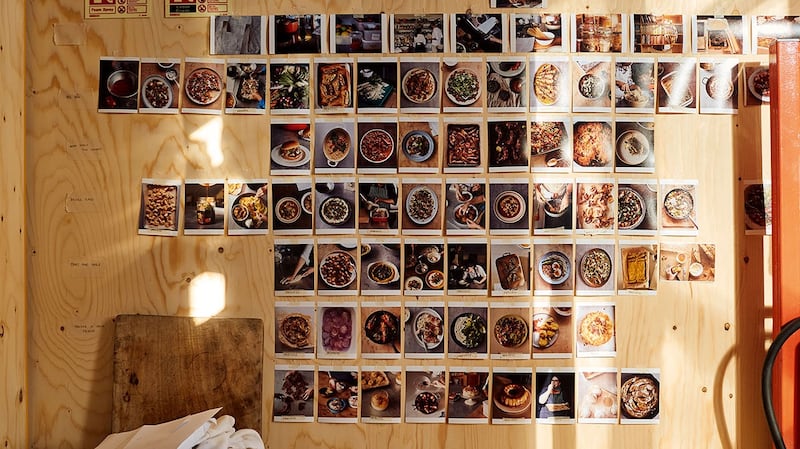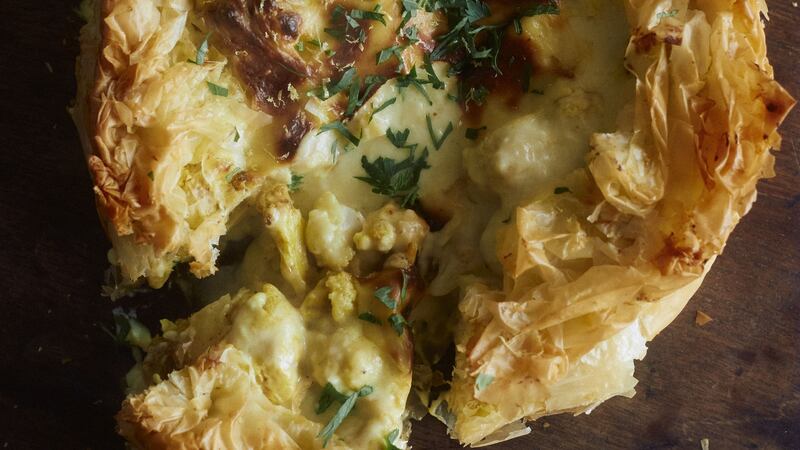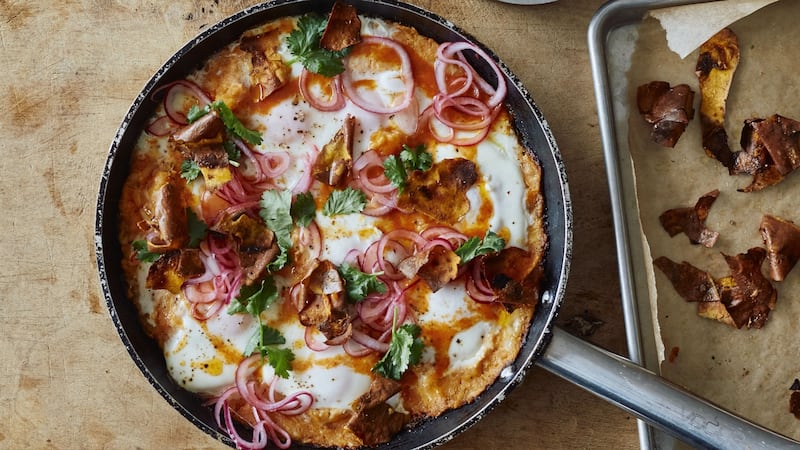Like all of us, Yotam Ottolenghi found himself cooking three meals a day in lockdown, and, for the first lockdown he was in Ireland with Karl Allen, his Northern Irish husband, and their two children, eight-year-old Max and six-year-old Flynn. In a quiet area in the North, he spent his time going on coastal walks and cooking with local ingredients from a neighbouring farmer.
The boys had clear ideas about what they wanted to eat, and life just became a lot simpler. So simple in fact, that one-pot dishes were what kept them all happy being full of flavour with a minimum amount of washing up. Crispy pasta was a clear winner.
“My kids are quite good eaters, but like any other kids, their favourite is spaghetti, or pasta or rice, they’re quite predictable,” he says on a Zoom call from his home in Camden, London. He’s in his kitchen, which is bright and airy, all white walls with – as you’d expect – a serious set-up of ovens and a sleek island for prep, with a modern glass chandelier and the green foliage of a large tropical plant bringing a vibrant accent of colour.
“They call it crispy pasta because it’s crisp on the outside where it hits the pan with the oil, so we all know what happens, those crusts you get with rice or pasta. And the chicken gives the pasta its flavour, so you don’t need to make a stock or anything,” he says. “There are always little hands grabbing the bits that are preferable, but since it’s normally just the four of us, there’s always plenty to go around.”
Ottolenghi and his test kitchen team were locked down in different parts of the world and they kept in touch by posting what they were cooking. “We were all doing things that are not part of our daily routine in cooking, so it became all about our families and the recipes we were cooking for them,” he says.
They soon realised that they had the perfect ingredients for a new cookery book, one that reflects what it is like to cook using ingredients that are readily available, including some quite exotic ones that have been sitting at the back of the cupboard, and we all know who’s responsible for a lot of that.
“I’m taking responsibility, first for filling up people’s pantries and now for starting to actually use everything,” he laughs. “Even myself, I say it jokingly, but it’s quite serious. I also have those kind of ingredients that are sitting there. I love cooking rice from the recipes that I’ve published. I always go for basmati or short grain, but brown rice, I don’t cook so much, so that had been relegated to the back, and I was going, okay, I’m going to use brown rice and I’m going to use polenta and all those ingredients that you want to cook more with. So, in that respect, I’m also like other people. It was really good to air out the cabinet, with cans and different beans.”

This cookery book may have us pulling out forgotten ingredients from the back of our shelves, but it is first and foremost about keeping things simple. “The attitude has changed,” he says. “I think there is less time for, excuse the language, bulls**t. I think the pandemic has had this crystallising effect on people and the way they think. So, it needs to be delicious, it needs to be doable. Life’s too short; you never know what tomorrow will bring you.”
As with all his recent books, Ottolenghi has collaborated with a member of his test kitchen team, and for Shelf Love it is with 31-year-old Noor Murad, a Bahraini who went to culinary school in the US, cooked in kitchens in Manhattan, and has been working with Ottolenghi for the past five years.
Murad found she was getting a huge amount of questions on hummus from her Instagram followers during lockdown, a dish that was second nature to her. So, she created a step-by-step guide to making the ultimate creamy dip, using dried chickpeas which are cooked, then peeled individually before being blitzed with the cold shock of ice in a blender. Finishing it with a topping makes it even more special. “I love making a brown butter and cooking it until it is really nutty, and then adding some pine nuts and a bit of smoky paprika, and just pouring that on top, that’s my favourite way,” she says.
With a combination of recipes from Murad and Ottolenghi, that use up cans of beans, dried chickpeas, pomegranate molasses and black limes, whatever you have lurking in your fridge or freezer, it seems this is the perfect book for delicious recipes that can slot into every day. And even though they are simpler, and have shorter ingredients lists than you would normally expect, they all have that Ottolenghi twist that makes them so special.
Shelf Love, by Noor Murad & Yotam Ottolenghi, is published by Ebury Press. Photography by Elena Heatherwick
Curried cauliflower cheese filo pie

Cauliflower cheese, but make it pie. This dish was once described as "molten-hot-cheese-lava" and we think that's pretty fitting for the ultimate comfort of comfort foods.
Serves 4, generously
Prep time: 20 minutes
Cook time: 1 hour 45 minutes
Ingredients
1 large cauliflower, trimmed and cut into bite-size florets (700g)
2tsp mild curry powder
3tbsp olive oil
100g unsalted butter, 50g cut into roughly 3cm cubes and 50g melted
75g plain flour
675ml whole milk
2 garlic cloves, crushed
1½tbsp English mustard
150g mature cheddar, roughly grated
6 sheets of good-quality filo pastry (we use feuilles de filo)
Salt and black pepper
1tbsp roughly chopped parsley, to serve
1½tsp lemon zest, to serve
Method
1. Preheat the oven to 180 degrees (fan). Line the bottom and sides of a 23cm springform cake tin with baking parchment.
2. Put the cauliflower on a large, parchment-lined baking tray and toss with the curry powder, half the oil, ½ teaspoon of salt and a good grind of pepper. Roast for about 20 minutes, until cooked through and lightly coloured. Set aside, and turn the oven temperature down to 170 degrees (fan).
3. Meanwhile, make the bechamel. Put the cubed butter into a medium saucepan on a medium-high heat and, once melted, whisk in the flour and cook for 1-2 minutes – it should start to smell nutty (like popcorn). Turn the heat down to medium and slowly add the milk a little at a time, whisking continuously to prevent any lumps, until incorporated and the sauce is smooth. Cook, whisking often, for about seven minutes, until thickened slightly. Off the heat, stir in the garlic, mustard, cheese and a quarter teaspoon of salt until the cheese has melted.
4. Keep your filo sheets under a damp tea towel to prevent them from drying out. In a bowl, combine the melted butter and the remaining 1½ tablespoons of oil and keep to one side.
5. Working one sheet at a time, brush the exposed side of the filo with the butter mixture and drape it into your prepared tin (buttered side up), pushing it down gently to fit. Continue in this way with the next filo sheet, brushing it with butter and then laying it over the bottom sheet, rotating it slightly so the overhang drapes over the sides at a different angle. Do this with all six sheets.
6. Spoon half the bechamel into the base and top with the roasted cauliflower florets. Spoon over the remaining bechamel, then crimp up the overhang so that it creates a messy “scrunched-up” border around the edges, leaving the centre of the pie exposed.
7. Brush the top of the filo border with the remaining butter mixture, then transfer the tin to a baking tray and bake for 30 minutes.
8. Using a tea towel to help you, carefully release the outer circle of the springform tin and return the pie to the oven for another 20-25 minutes, or until the sides are nicely coloured and everything is golden and bubbling. Leave to settle for 15 minutes.
9. Top the pie with the parsley and lemon zest and serve warm.
Sweet potato shakshuka with sriracha butter and pickled onions

A far cry from a classic shakshuka, yes, but we've found that sweet potatoes provide just the right amount of moisture and heft to serve as a base for these eggs. Serve this vibrant dish as a weekend brunch; it sure looks the part.
Serves 4
Prep time: 20 minutes
Cook time: 1 hour 20 minutes
Ingredients
1kg sweet potatoes, skin on and scrubbed clean
1 small red onion, thinly sliced into rounds (100g)
2tbsp lemon juice
3tbsp olive oil
150g mature cheddar, roughly grated
3 garlic cloves, crushed
1tsp cumin seeds, roughly crushed with a pestle and mortar
8 medium eggs
25g unsalted butter
3/4tbsp sriracha
2tbsp picked fresh coriander leaves, with some stem attached
salt and black pepper
Method
1. Preheat the oven to 200 degrees (fan). Poke the sweet potatoes all over with a fork (about 8-10 times) and place on a medium, parchment-lined baking tray. Bake for 45-50 minutes, or until cooked through and softened. Set aside to cool and turn the oven temperature down to 180 degrees (fan).
2. Meanwhile, in a small bowl mix together the onion, one tablespoon of lemon juice and a pinch of salt and set aside to pickle.
3. Remove the cooked potato skins and tear them into roughly 4cm pieces. Transfer the potato flesh to a large bowl and set aside. Place the skins back on the baking tray and toss with one tablespoon of oil, a quarter teaspoon of salt and a good grind of pepper. Bake for eight minutes or until nicely coloured and starting to crisp up. Set aside to cool and crisp up further.
4. Use a fork to mash the potato flesh until smooth, then add the cheddar, garlic, cumin, another tablespoon of oil, the remaining tablespoon of lemon juice, one teaspoon of salt and a generous grind of pepper, and mix to combine.
5. Put the remaining tablespoon of oil into a large frying pan, for which you have a lid, and swirl around to coat the bottom. Spoon the mashed potato mixture into the pan, using your spoon to distribute it evenly. Place on a medium-high heat and leave to cook for about seven minutes, for the bottom to start to colour. Turn the heat down to medium and use a spoon to make eight wells in the potato mixture, breaking an egg into each. Sprinkle lightly with salt and pepper, cover with the lid and cook for 4-5 minutes, rotating the pan, or until the whites are set and the yolks are still runny.
6. While the eggs are cooking, put the butter and sriracha into a small saucepan on a medium heat and cook until the butter has melted, whisking constantly to emulsify. Remove the mixture from the heat before it starts to bubble – you don’t want it to split.
7. When ready, spoon the sriracha butter all over the eggs, then top with a good handful of the crispy potato skins, half the pickled onion and all the picked coriander leaves. Serve right away, with the rest of the potato skins and pickled onion to eat alongside.
Make it your own:
- Save time by cooking the sweet taters in the microwave instead.
- Use any kind of oozy melty cheese and any spice you like for the base.
- Experiment with other hot sauces, such as Tabasco or harissa.









